By Dorothy Halverson, Director of Principia Acorn Programs
These friends are enjoying pouring water from one cup to another, using water to spin the waterwheel, making bubbles with the beaters, and just feeling the water run through their fingers. While they are having fun exploring, they are also learning about cause and effect, about warm and cool, about floating and sinking. They love learning new words, feeling the calming effect water play brings, and thinking about the wetness of the water and the bubbliness of the bubbles.
Young children are naturally drawn to water and they are curious about it. It’s a universally appealing, natural play substance with unlimited possibilities.
So what does a child learn from playing with water, besides getting wet?
Your Child, the Great Explorer
One of the big lessons young children are learning is how the world works. They are actively exploring the environment around them using all of their senses. Young children are very tactile and they want to know how the world really works, how it tastes and smells and feels, and how bouncy it is if you jump really hard on it. They enjoy all kinds of sensory activities—and water play is one of these.
When your child is exploring, take your cues from him. He will show you what he’s interested in. It might be as simple as watching the bubbles flow off his fingers under the running water in the sink. It’s really about the child and what he or she wants to do.
Children like to play in the sink while they wash their hands and look at themselves in the mirror. Try filling a large plastic container with water and placing it on a low table or outside in the grass. Add natural materials to the water for your child to explore—like pine cones and leaves. Talk about what happens to the leaves when they get wet. It’s a very simple, natural process of following a child’s interest.
Water and Words
Water play is also about words. Any experience you have with your child can be about words, and water is certainly an interesting topic for a little person. Have conversations about water with your little one and discover language together. Talk about the water pouring and splashing and drizzling. Extend his language with descriptions.
Even if your child isn’t talking much, he is taking in everything you say, and his language skills are developing. You help that process along when you talk to him or read to him. Stories that describe the properties of water can add to your child’s growing knowledge of water. Have a look at Big Sarah’s Little Boots by Paulette Bourgeois (Published by Kids Can Press), The Mud Puddle by Robert Munsch (Annick Press), or D.W. All Wet, by Marc Brown (Little, Brown).
Get in the Game
Water play is another opportunity to show your child that you like playing with him and that you value him and the activities he enjoys. So don’t sit by with a towel (or a raincoat). Play with him, squish through the soggy mud. Show him that you’re interested in his experience with water, that you want to be there splashing with him, and that you enjoy being part of his play!
Involve your child in water play around the house, too. He’ll love to be included in the things you do. Invite your child to add water to your powdered drink mix, stir, and drink it up. It’s exciting to make something real and then serve a drink to the rest of the family. Your child can “wash” the plastic drinking cups at the kitchen sink, or watch the clothes slowly submerge as the washer fills.
The Great Wet Outdoors
Sure, summer is a great time for sprinklers and bubbles, but water play outdoors can be a year-round activity. Spring is perfect. It comes with puddles and mud. Add boots, raincoats, and fleece jackets and follow your child out the door. He’ll know what to do next.
In the winter, bring some snow inside and watch what happens. Notice the dripping icicles on a warm winter day. There are lots of creative possibilities—the drippy snow, the fluffy snow. Children can take handfuls of icicles to break–the sound they make is amazing. Best of all is stomping through puddles that have frozen with a thin layer of ice—what power!
In the Swim
Another way to enjoy the water together is to get right into it—into the pool, that is. What can you expect at a “Baby and Me” swimming lesson? Fun! A typical Baby and Me class will include skills, songs, games, and lots of ways to stimulate the child.
Swimming lessons make the most of modeling. For instance, the parent blows bubbles; the child sees that it’s fun to blow bubbles; and, eventually, he’s doing it, too. Learning skills are incorporated into the songs and games in a very subtle and fun way.
Keep your expectations of swimming lessons realistic. A toddler may learn to splash and blow bubbles, and he’ll feel more comfortable in the water, but he isn’t going to be “water safe” for a long time yet. The bottom line for safe water fun is to stay with your child and supervise closely. If your child is not within arms’ reach, you’re too far away—even in a lesson setting.
Calming Waters
The interesting thing about water is how it can create uproarious, screaming, splashing fun, but it can also calm the fussiest baby. Water is a soothing substance. If your little one has had a rough day, and nothing you do seems to help, running a bath and sitting down next to your child while he plays in the tub will often change his mood.
There’s nothing like a soothing bath after a full day . . , add some bubbles, a few plastic boats and ducks, and some cups and basters to the bath. Your child will love exploring in the water.
On the Safety Side
- Small children need close, constant adult supervision when they’re playing around water, whether it’s in the bathtub, backyard wading pool, or dishpan. Be vigilant.
- Empty buckets and dishpans when your child is finished playing. Make cleanup part of the exploration. Your child can help you pour the water down the drain, watch it disappear, and then wonder together where the water ends up.
- Take extra care that the floor, sidewalk, or lawn doesn’t get wet and slippery when you’ve been playing for a while. Keep a couple of big towels handy. If you’re outside, move the game around so surfaces don’t get slippery or soggy.
Fun Water Play Ideas for Young Children
- Ice cubes are fun! They’re cold and slippery, and they disappear right before your eyes.
- Gather up some dolls’ clothes or dolls’ dishes, add a squirt of very mild soap to a little pan of water, and your child can do laundry the old-fashioned way.
- Add food coloring to a container filled water.
- Discover all the water toys available in the kitchen: big and small plastic spoons and scoops, funnels, colanders, sieves, turkey basters, sponges, slotted spoons. Assign some old plastic containers to permanent play duty and poke a few holes in the bottom—one hole makes a little stream that lasts a long time; a bunch of holes makes an impressive shower.
- Fill a large margarine tub or jelly mold with colored water and freeze. These can become bricks in your snow fort or be allowed to melt slowly in the bathtub or swimming pool. Place a plastic toy in the water before you freeze it and your child will delight in discovering it.
- Put some water in a plastic spray bottle. A well-cleaned out window cleaner bottle works well. Water the plants or the lawn, or spray the side of the house.
- Provide a bucket of water and a clean paint brush and invite your child to “paint” the side of the house or the sidewalk. A roller brush is even more interesting.
- Have a tea party with a tiny tea pot, tea cups, and snacks. Invite some bears and other members of the family. Eat, drink, sit on little chairs, and be merry.
- Fill a clear plastic jar with water and show your child how big his hand looks through the magnifying bottle.
- Set out a container of water and some toys to experiment with—a plastic doll that floats, a little car that doesn’t, a wooden block, a sponge, a bar of Ivory soap, some ice cubes that float . . . but ,wait a minute, where are they? Have a conversation about what happened to the ice cubes. Talk about which objects float in the water and which objects sink.
Remember: Any time your child is near water of any amount, close supervision is imperative. Have fun and enjoy this special time with your child.



 Directions
Directions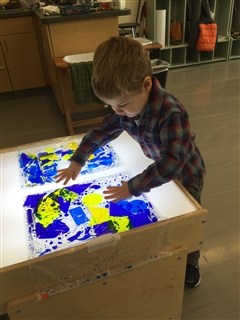
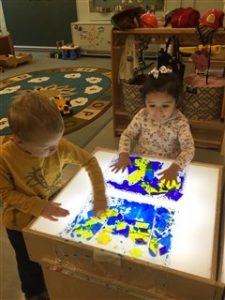
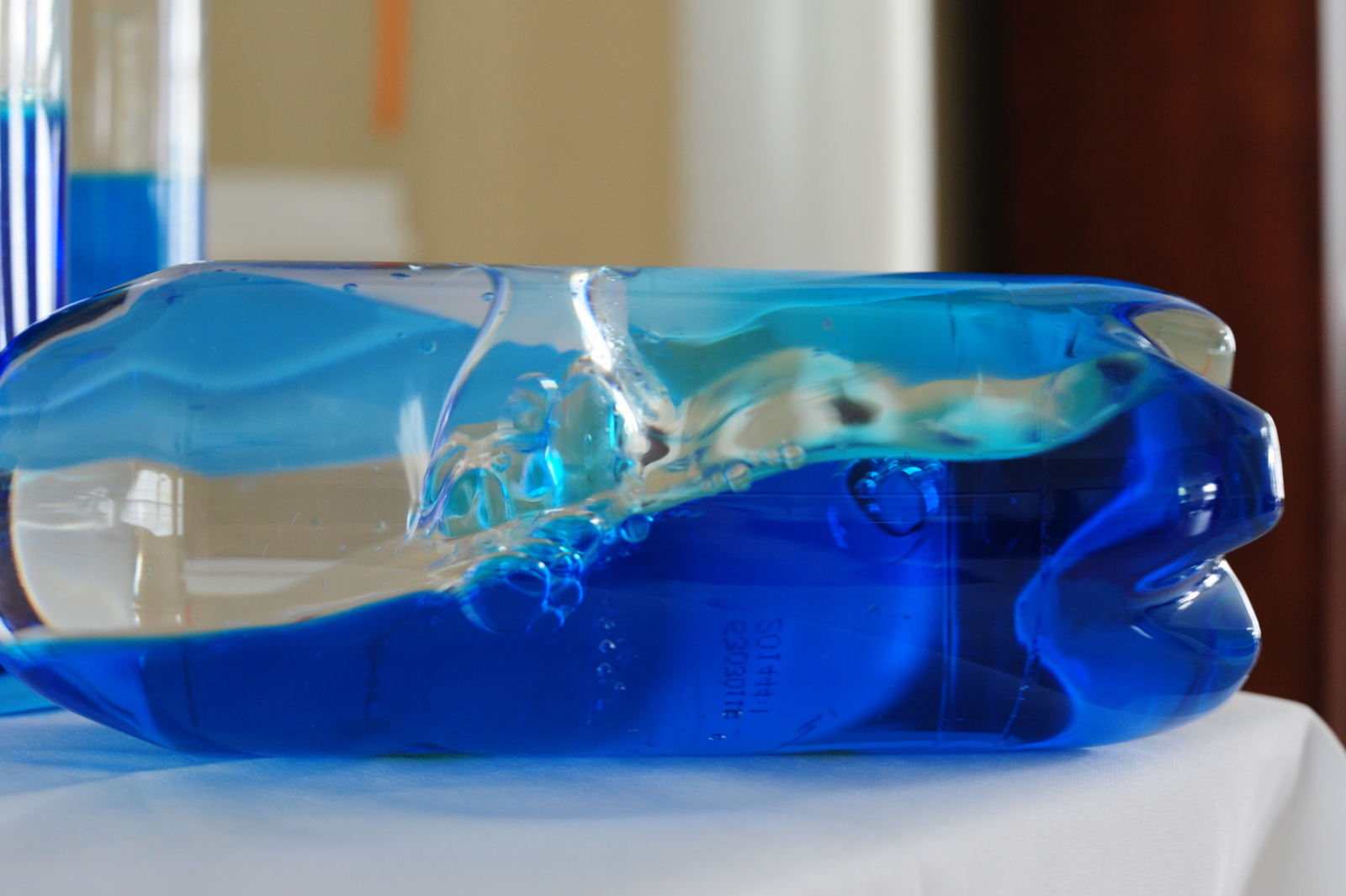

 Directions
Directions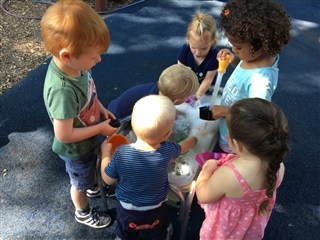
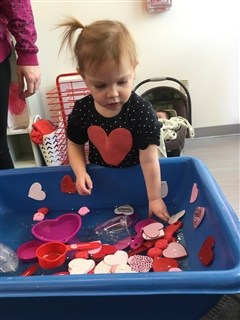
 Materials
Materials Directions
Directions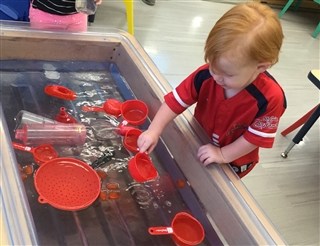
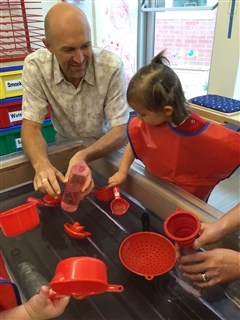
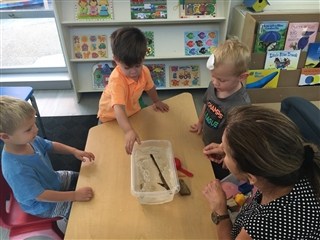
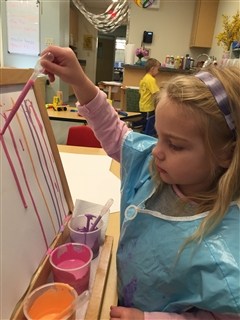

 Directions
Directions